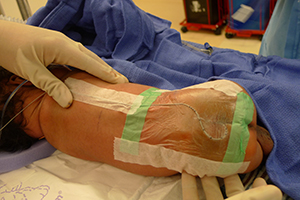- Continuous Epidural Analgesia in Neonates and Infants: Strategy for Success or Recipe for Disaster? (L224)
- 11 a.m.-Noon Sunday
- BCEC Room 052A
Pain management in sick infants poses a challenge when the options all seem to have significant risks. Using continuous epidural analgesia is a consideration that will be explored Sunday during a Problem-Based Learning Discussion.
“Epidurals in neonates and infants are not done that commonly, so that creates issues related to expertise and maintaining skills. Patient selection in light of expected risks and benefits is extremely important. Once we have decided to proceed, we have to ask, ‘What are the things we can do to make sure the outcome is favorable for the patient?’” said Alina Lazar, M.D., who will lead the discussion.

Alina Lazar, M.D.
Dr. Lazar, an Assistant Professor at the University of Chicago, will explain the technique she uses when placing catheters for epidural analgesia in neonates and infants, with a focus on safety.
“We will talk about the anatomy, physiology and pharmacology differences in neonates versus older children and adults,” Dr. Lazar said. “We will talk about complications that could occur, how to prevent and manage those and what systems we should have in place for a positive outcome.”
The main alternative to an epidural is intravenous opioids, which have many disadvantages, she said. An option showing promise is a paravertebral nerve block, but its use in neonates has been limited.

An infant with a catheter inserted for epidural analgesia. Photo courtesy Alina Lazar, M.D.
Most complications when using an epidural on neonates and infants occur in the postoperative period. They usually involve catheter dislodgement and infection, but devastating neurologic injury also has been described, Dr. Lazar said.
“Another postop complication is administering the wrong dose of medication,” she said. “Children, especially neonates, are at high risk for toxicity from local anesthetics. The local anesthetic doses we are infusing are close to the toxic range. The other problem is that pain assessment in neonates is difficult. Irritability may indicate pain, other sources of discomfort or even anesthetic toxicity.
“The take-home message is that people need to get a sense of what happens once you drop the patient in the NICU. Who is taking care of the patient, and are they comfortable with epidurals? What fail-safe mechanisms are in place to prevent bad outcomes? Good communication between anesthesia and the NICU is crucial.”
Return to Archive Index